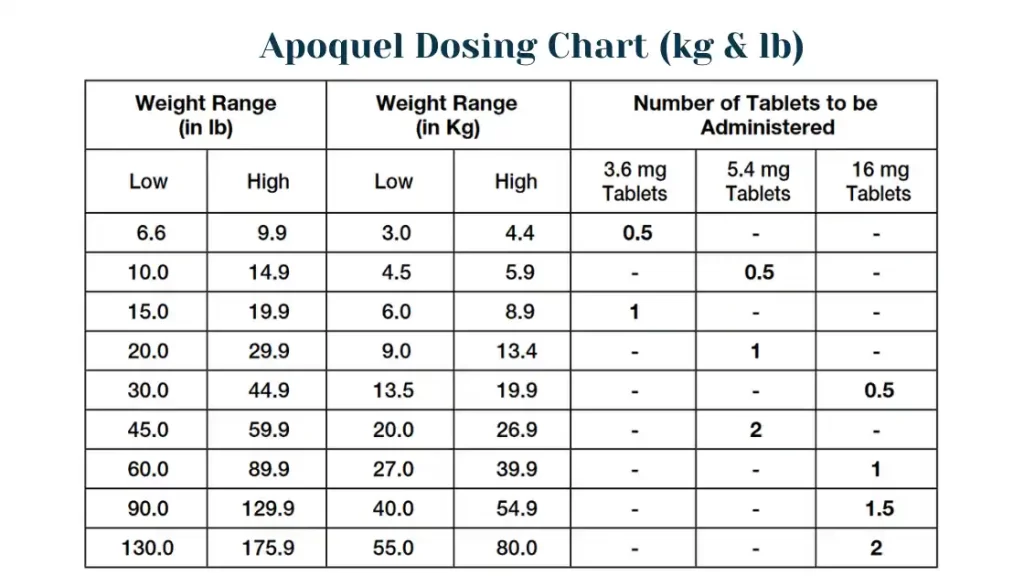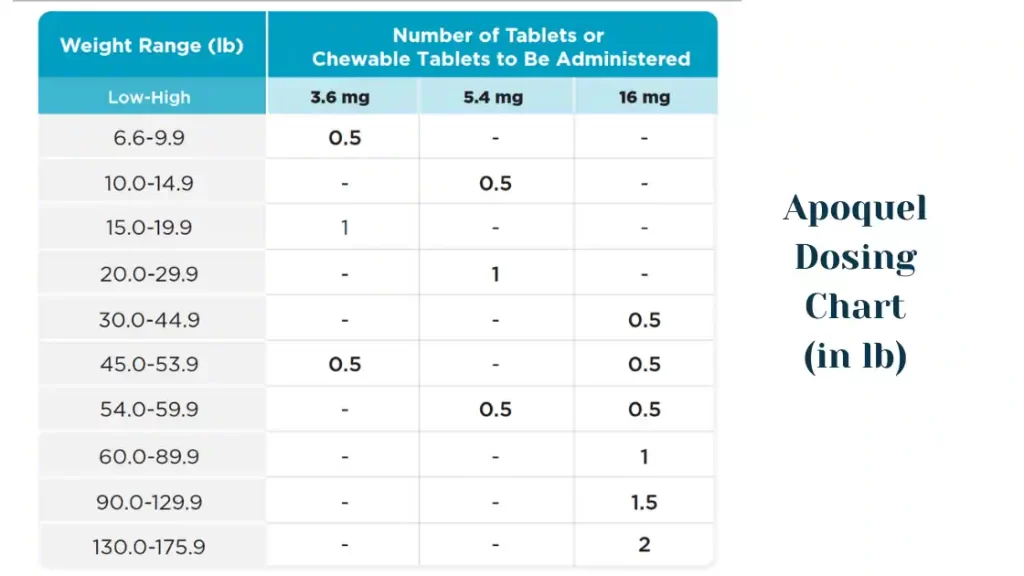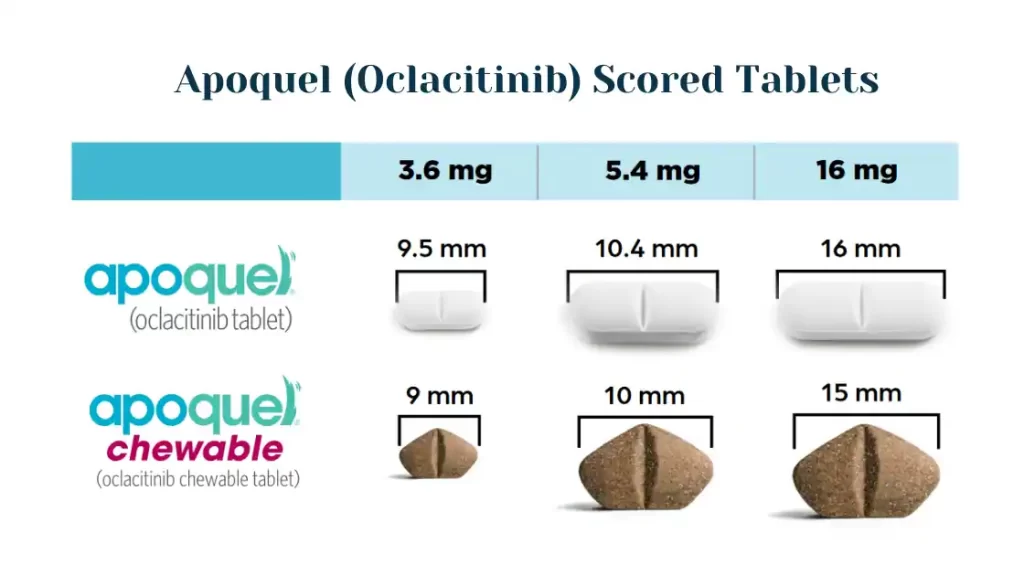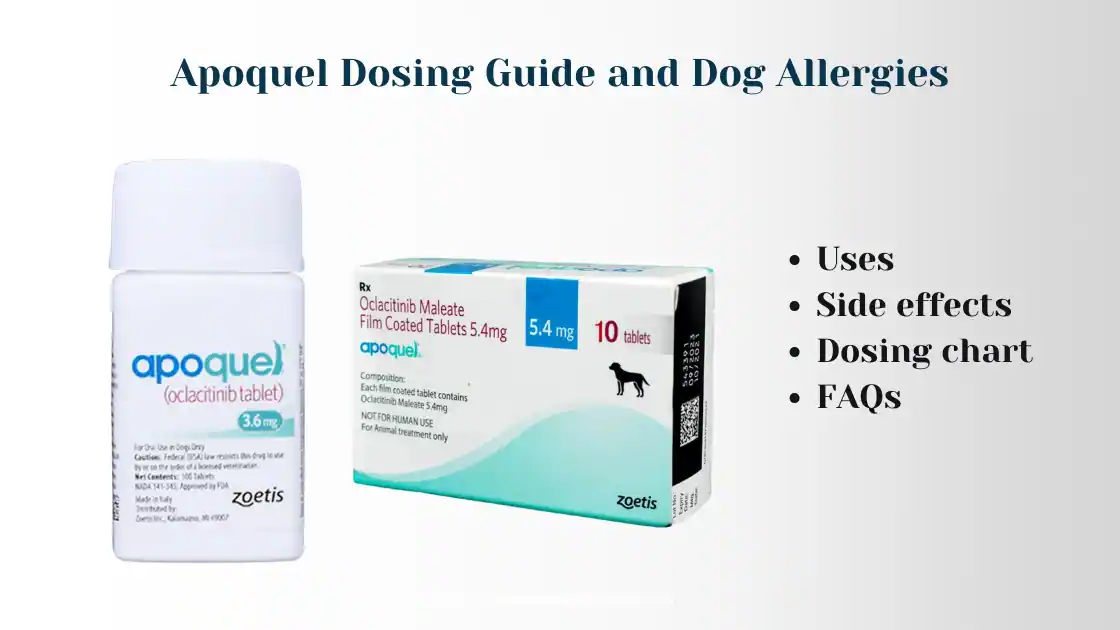Skin allergies in dogs can be a distressing experience for both pets and owners. Oclacitinib (Apoquel) offers relief from allergies like atopic dermatitis or FAD, but proper dosing is very important. Learn about its uses, dosing guidelines, and potential side effects to ensure your dog’s well-being. With careful administration and monitoring of possible side effects, Apoquel can provide much-needed relief, enhancing your dog’s quality of life.
Oclacitinib (Apoquel) Dosing Chart for Dogs and Guidelines
Skin allergies in canine companions can be a distressful ordeal, both for the pets and their owners who have to watch them suffer through constant itching and discomfort. Advancement in veterinary medication have paved the way for innovative treatments, one of which is oclacitinib, commercially known as Apoquel. Some dogs may experience a few side effects and appropriate dosing according to body weight is very important.
Oclacitinib, branded as Apoquel, is a medication that has revolutionized the treatment of allergic dermatitis and atopic dermatitis in dogs. Developed specifically for canines, it belongs to a class of drugs known as Janus kinase inhibitors that plays a crucial role in modulating the immune system (immunosuppressant). By selectively targeting the pathways or enzymes involved in allergy and inflammation, Apoquel effectively manages itching and inflammation without the severe side effects typically associated with steroids.
When is Apoquel Prescribed?
Veterinarians may prescribe Apoquel for dogs experiencing:
• Chronic or acute allergic dermatitis
• Atopic dermatitis
• Intermittent or persistent itching
While Apoquel is a breakthrough treatment that can offer rapid relief within 4 hours of the first dose, it is not a cure for allergies. Root cause like elimination of allergens, supportive supplementation and dietary modifications must be made along with treatment. It’s used as a symptomatic treatment to alleviate discomfort, allowing for a better quality of life.
Apoquel Dosing Chart for Dogs
Apoquel is available in tablet form, making it convenient for pet owners to administer the medication. It’s of utmost importance to administer according to the weight of the dog to ensure its effectiveness and safety without risking side effects.
Apoquel dose for Initial therapy:
0.4 to 0.6 mg /kg bodyweight or 0.18 to 0.27 mg/lb, administered orally, twice daily for up to 14 days.
Apoquel dose for maintenance therapy (after the initial 14 days):
0.4 to 0.6 mg /kg bodyweight or 0.18 to 0.27 mg/lbshould then be given only once a day.
Dosing for apoquel tablet and chewable tablets are same.
The dosing chart may vary based on the dog’s weight and the severity of the condition. The following is a commonly used dosing chart; however, always follow the specific instructions given by your dog’s veterinarian.
Apoquel Dosing Chart for Dogs (Kg)
Bodyweight (kg) Strength and number of tablets:
3.6 mg 5.4 mg 16 mg
3.0-4.4 ½
4.5-5.9 ½
6.0-8.9 1
9.0-13.4 1
13.5-19.9 ½
20.0-26.9 2
27.0-39.9 1
40.0-54.9 1 ½
55.0-80.0 2
Dogs should be carefully observed following administration to ensure that each tablet is swallowed.

Apoquel Dosing Chart for Dogs (lbs or Pounds)
Weight of Dog Dose of Apoquel (oclacitinib)
6.6-9.9 lbs 1.8 mg (3.6 mg half tablet)
10-14.9 lbs 2.7 mg (5.4 mg half tablet)
15-19.9 lbs 3.6 mg (3.6 mg one tablet)
20-29.9 lbs 5.4 mg (5.4 mg one tablet)
30-44.9 lbs 8 mg (16 mg half tablet)
45-53.9 lbs 9.3 mg (16 mg half tablet & 3.6 mg half tablet)
54-59.9 lbs 10.2 mg (5.4 mg half tablet & 16 mg half tablet)
60-89.9 lbs 16 mg (16 mg one tablet)
90-129.9 lbs 20 mg (16 mg one and 3.6 mg one tablet)
130-175.9 lbs 24 mg (16 mg one and half tablet)
Initial and maintenance therapy doses must be followed accordingly.
Dose may vary and depends on body weight.

Important Dosing Guidelines:
For initial therapy of 14 days administration typically involves twice-daily dosing and after that for maintenance therapy and depending on the dog’s response, sometimes the dose can be tapered to once daily.
For proper dosing and avoid potential side effects dogs should be weighed accurately. Apoquel is not recommended for use in dogs less than 12 months of age.
To avoid the risk of gastrointestinal side effects or upset always give oclacitinib with food or after a meal. It’s important to note that Apoquel should be given with food for optimal absorption.
Recognizing and Understanding Side Effects
While Apoquel has its effectiveness in pruritis, like all other medications, it can have some side effects. Most of the dogs tolerate the drug well, but it is important to be vigilant and report if you notice any discussed in the post.
Potential side effects of Apoquel include:
Like any medication, it may come with some (potential) side effects. Understanding these side effects is crucial for pet owners to monitor their dogs’ well-being closely.
- Gastrointestinal Issues: Dogs receiving medication may experience mild digestive upset including lack of appetite, vomiting, excessive thirst and diarrhea. It’s recommended to administer Apoquel with food to minimize these effects.
- Increased Susceptibility to Infections: Oclacitinib works by suppressing the immune system, potentially making dogs more vulnerable to infections like yeast skin infections and otitis, cystitis like conditions. It may also decrease mean leucocyte count. Regular veterinary check-ups are essential to monitor overall health.
- Increased Liver Enzymes: In some cases, Apoquel may lead to elevated liver enzymes and serum cholesterol. Regular blood tests can help monitor liver function and detect any abnormalities early on during the therapy.
- Neoplasia: There have been reports of an increased risk of neoplasia (tumor formation), development of non-specific skin lumps and papilloma in dogs receiving Apoquel. It’s crucial to discuss this risk with your veterinarian, especially for dogs with a history of cancer or on therapy for such ailments.
- Behavioral Changes: Some dogs may exhibit changes in behavior, such as increased aggression or lethargy. Monitoring your pet’s behavior and promptly reporting any changes to your veterinarian is essential for timely modification of therapy or other alternatives.
When to Contact the Veterinarian
If any of the above or other unlisted side effects occur or suspected, or if your dog’s allergies do not seem to be improving with initial therapy, it is important to consult with your veterinarian. Never adjust the dose or discontinue use of Apoquel without professional guidance.
Monitoring and Follow-up
As apoquel may have some potential side effects so your veterinarian may recommend regular check-ups to monitor your dog’s health and response to treatment. Blood tests are needed to ensure that the drug isn’t causing harm to your pet’s health overall.
Conclusion on Apoquel Usage in Dogs
Apoquel (Oclacitinib) has good impact in the management of canine allergic dermatitis and undoubtedly has revolutionized the treatment. However, its use must be carefully used with an understanding of the potential side effects and the necessity for proper dosing. Always listen to your vet, report side effects promptly, and ensure that your pet’s treatment journey is as comfortable as possible.
Remember, providing relief from allergies can significantly improve your pet’s well-being and strengthen the bond you share. Managing allergies can be a long-term commitment, but with the right approach and medications, it’s possible to offer your dog a happier, itch-free life.

Image and Chart Credits (Zoetis US)
Frequently Asked Questions (FAQs) about Apoquel Dosing for Dogs:
Can I give Apoquel to my dog without consulting a veterinarian?
No, it is strongly advised against administering any medication without consulting a veterinarian. It is also important to treat dogs for food hypersensitivity, fleas or other factors responsible for itching along with oclacitinib. Your vet will assess your dog’s specific condition, weight, and overall health to determine the appropriate dosage and duration for Apoquel.
How long does it take for Apoquel to start working?
Apoquel is known for its rapid onset of action, often providing relief within 4 hours. However, the full therapeutic effect may take a few days to manifest. It’s essential to follow the prescribed dosage and be patient while waiting for improvement.
Can Apoquel be used for long-term treatment?
Yes, Apoquel can be used for long-term treatment, but it’s crucial to monitor side effects, revaluation of therapy and follow your veterinarian’s guidance. Depending on your dog’s condition, your vet may adjust the dosage or recommend intermittent use to manage symptoms effectively.
Are there any breed-specific considerations for Apoquel use?
While Apoquel is generally safe for most breeds, certain dog breeds may be more prone to specific health issues. It’s important to discuss your dog’s breed and any potential concerns with your veterinarian to ensure the safest and most effective treatment plan.
Can Apoquel be used alongside other medications or treatments?
Your veterinarian will determine the best course of action based on your dog’s individual needs. Skin infections may need antibiotics for effective management. It’s crucial to inform your vet about any other medications or treatments your dog is receiving to avoid potential interactions.
Are there any dietary restrictions while using Apoquel?
Apoquel should be administered with food to enhance absorption and reduce GI signs. However, there are no specific dietary restrictions associated with Apoquel use. It’s always a good idea to discuss your dog’s diet with your veterinarian for overall health considerations and manage diet induced canine atopic dermatitis.
What should I do if I miss a dose of Apoquel for my dog?
If you miss a dose, administer it as soon as you remember. However, if it’s close to the next scheduled dose, skip the missed one and resume the regular dosing schedule. Do not double up on doses unless directed or recommended by your veterinarian.
Can Apoquel be used in pregnant or nursing dogs?
The safety of Apoquel in pregnant or nursing dogs and breeding males has not been well-studied, so it’s important to consult with your veterinarian. Outweigh the potential risks and benefits before prescribing the medication for a pregnant or lactating dog or dogs intended for breeding.
What signs should I watch for that may indicate a negative reaction to Apoquel?
Keep a close eye on your dog for any signs of adverse reactions, including nausea, vomiting, diarrhea, changes in behavior like aggression, formation of cutaneous lumps, or difficulty in breathing. If you observe any concerning symptoms, contact your veterinarian promptly.
Is Apoquel a cure for allergic dermatitis, or is it just a management tool?
Apoquel is primarily a management tool that effectively controls the symptoms of allergic dermatitis. While it provides relief from itching and inflammation, it does not cure the underlying cause. Regular veterinary check-ups are essential to monitor your dog’s condition and adjust the treatment plan as needed.





